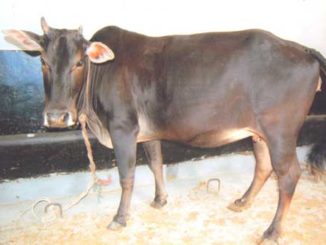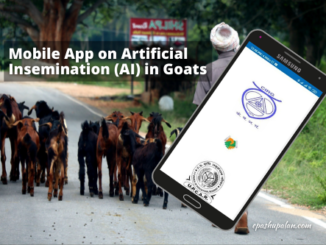Dystocia means difficult birth. It is an emergency condition and necessitates its early handling by an obstetrician/V.O. in order to save the life of calf/ dam or both.
Causes of Dystocia
Basic causes
Hereditary, nutrition, management and infections.
Immediate causes
Maternal and fetal causes: Fetal causes of dystocia is more common than maternal dystocia in monotocus sps.
- Disproportionate size of fetus (Fetopelvic disproportion) leads to dystocia due to following conditions: Absolute oversize of fetus
- Oversize due to developmental defects: (a)Schistosoma reflexus, (b) Perosomus elumbis, (c) Double monster, (d) Achondroplasia
- Pathological oversize of fetus: Hydrocephalus, Ascites Anasarca, Polysarca, Emphysema.
History
Continuous straining for a long duration but parturition is not completed.
Clinical examination: P/V Examination
- The fetus is in normal position
- Dilatation of birth canal (cervix, vagina and vulva) has taken place
- Abdominal contractions (straining) is present.
Treatment
- Slight traction is applied after adequate lubrication.
- If there is too much difficulty to expel the fetus, repulsion and rotation are performed followed by traction.
Supportive Therapy
- Intravenous fluid, Prostaglandin, Oxytocin
Sequele
Secondory uterine inertia, Eversion of uterus, R.F.M., Metritis, Endometritis, infertility and sterility.
Dystocia in order of there decreasing frequency
- Oversize fetus
- Postural defects
In anterior presentation
- Carpal (knee) flexion.
- Lateral deviation of head & neck.
- Shoulder flexion.
Note: All postural deviations can be easily corrected by manipulation provided treatment forth coming in early second stage of labour.
Delayed Cases
When fetus is dead, emphysematous, loss of fetal fluid etc. It requires either fetotomy or caesarian section.
Prerequisite for correction of postural defect by manipulation
- Epidural anesthesia
- Repulsion; followed by correction.
- Delivery by force traction after successful correction.
(A) Correction of Carpal (knee) Flexion
In simplest cases
With unilateral knee flexion:
- Flexed carpi engaged at pelvic inlet, other limb appears at vulva.
- Repulsion at fetal head or shoulder.
- Grasping the flexed carpi and pushing it upward.
- Foot is carried outward and brought forwarded in an arc over the pelvic brim.
- Guiding hoof making the cup of hand.
In complex cases
- Apply snare at the region of fetlock.
- Other procedure remains same as mentioned above snare at fetlock helps in traction.
In Delayed cases
- Lubrication followed by correction.
- More Delayed cases/ Ankylosed limb relieved by fetotomy.
(B) Correction of shoulder flexion
Diagnosis
In bilateral flexion, appearance of muzzle at the vulva without any foot, whereas in unilateral flexion; a foot along with muzzle at vulva.
In simple cases
In a multiparous animal with premature calf- fetus is removed by force traction without correction i.e. in flexed condition removed by force traction.
In other cases with mature calf
- Repelling the fetus back.
- Grasping the forearm and converting in carpal flexion.
- Rest procedure is same as in carpal flexion.
In Delayed cases
When fetus is dead and emphysematous
- Decapitation i.e. removal of head at atlanto-occipital joint through fetotomy.
- Rest as mentioned above.
In more difficult cases
- Apply snare/chain at proximal extremities and then slip the snare above fetlock.
- While applying traction on the snare simultaneously the foot is brought outward in the form of an arc above the pelvic brim.
- Precaution is to be taken to guard the hoof forming the cup of the hand.
(C) Lateral Deviation of head and Neck
Fresh case
when treatment starts at an early second stage of labour.
- At this stage correction can be done by using hand alone.
- Repulsion of the fetus by hand from base of the neck.
- Firmly grasp the muzzle and brought round through an arc until nose is in line with birth canal.
In more inaccessible cases
Where muzzle is not in approach, apply slight traction on the commisure of the mouth or mandible by hand alone and thereafter grasping the muzzle and handle in similar manner as described above.
In more protected cases
When there is loss of fetal fluids along with contracted uterus.
- Give epidural anesthesia.
- Replace fetal fluids by use of artificial lubricants.
- A snare having a running noose is applied over the mandible, tightened and traction applied to it and simultaneously the deviated head is corrected as above.
- Precaution is to be taken that snare should around the greater curvature of the neck to the mandible.
In very obstinate delayed cases
or with wryneck condition better to perform fetotomy.
Postural defects in posterior presentation
(A) Hip flexion posture
When both hind limbs are retained in the uterus, a common condition than unilateral retention is termed as breech presentation. If it is delayed it becomes most difficult type of dystocia dealt with veterinary obstetrician.
Diagnosis
On par-vaginal examination only calf’s tail is observed.
Treatment
- The aim of treatment is to convert the condition into one of hock flexion posture and then proceed accordingly.
- In recent cases epidural anesthesia and fetal fluid supplement will not be needed but in protracted cases both will be invaluable.
Steps
- To repel the calf’s perineum forwards and upwards with a view to bringing the retained limbs within reach.
- When leg may be grasped as near to the hock as possible traction on the limb converts the posture into hock flexion.
- The fetus is repelled by pressing forward in its perineum and the hand then grasp the fetal foot.
- As the foot is drawn back through an Arc, the hock is firmly flexed and retropulsion maintained as for as possible.
- Foot is lifted with the points of the digits in the cupped hand, over the pelvic brim and the limb extended in the vagina.
(B) Hock flexion posture
Correction is done as mentioned above
Reference
- Veterinary Reproduction and Obstetrics Tenth edition(2019) . David E. Noakes, Timothy J. Parkinson and Gary C. W. England
|
The content of the articles are accurate and true to the best of the author’s knowledge. It is not meant to substitute for diagnosis, prognosis, treatment, prescription, or formal and individualized advice from a veterinary medical professional. Animals exhibiting signs and symptoms of distress should be seen by a veterinarian immediately. |






1 Trackback / Pingback